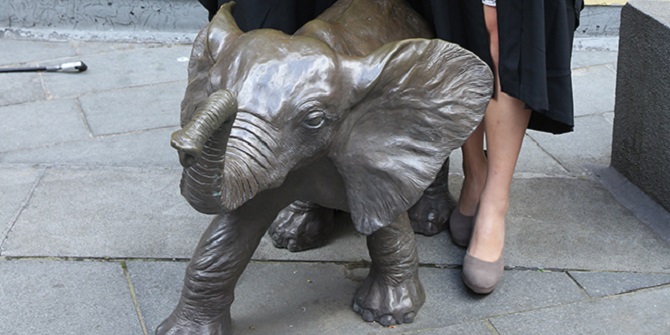Not all of LSE’s art works are on public display. LSE Archivist Sue Donnelly explores the School’s connection with railway art and this 19th century lithograph of a railway scene.
View of a Train of Carriages Drawn by a Locomotive Steam Engine on a Railway was published in around 1830. The lithograph was printed by R Martin of 124 High Holborn, London and taken from a painting by Charles Vignoles, engineer. The lithograph shows the locomotive Novelty, pulling four carriages, two of which carry private carriages.

Novelty was a locomotive built by John Ericsson and John Braithwaite to compete in the 1829 Rainhill Trials for the commission to build locomotives for the new Liverpool to Manchester Railway. Five locomotives competed in the trials and Novelty, as a light and fast engine, was at the cutting edge of technology – on the first day of the trials it ran at 28 mph. Unfortunately it twice suffered a damaged boiler pipe leaving the slower Rocket built by Robert Stephenson as the eventual winner.

Charles Blacker Vignoles (1793-1875) was born into an army family and after attending Royal Military Academy at Woolwich served in the Royal Scots at the siege of Bergen Op Zoom in 1814, and in Canada. After the war Vignoles was placed on half-pay and began working as an engineer and surveyor. In the 1820s he worked on several railway projects including Liverpool to Manchester Railway and London to Brighton. Later he worked on railways in Germany, Spain and Brazil as well as designing the Kiev Bridge in Ukraine – a one and a half mile long suspension bridge. He was also Professor of Engineering at University College, London and in 1869 became the 15th President of the Institute of Civil Engineers.

Charles Vignoles worked with the George and Robert Stephenson on the construction of the Liverpool to Manchester Railway but resigned after a disagreement about the measurements of the Edge Hill Tunnel running into Liverpool. Vignoles appears to have had a connection with the development of Novelty for the trials though the nature of his involvement is unclear.
The lithograph was published by Robert Martin of 124 High Holborn. According to his biographical details at the British Library he lived from the 1770s to1838 and had a number of addresses including at Carey Street, Long Acre and St Martin’s Lane.

There is no information on the provenance of the print but its presence in the School’s collections, along with other railway prints, may reflect the School’s close connection with the railway industry.
Amongst the first staff at LSE was William Acworth, a leading expert on railway economics and from 1903 to 1949 (with a break during the Second World War) the School’s Railway Department ran a course for railway clerks supported by many of the major railway companies. Topics covered included Railway Organisation, Railway Commercial Economics, Law of Carriage by Railway and railway statistics. The Brunel Silver Medal was awarded to the top students in each year. For many years the fees from the railway courses were vital to the School.






I have this print. Anyone know it worth?
I have this exact print, anyone know it’s value?